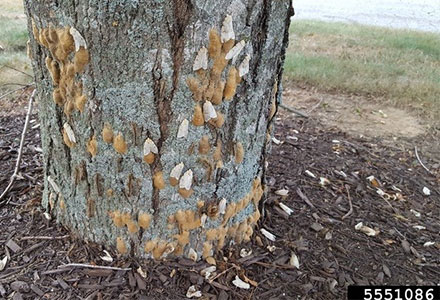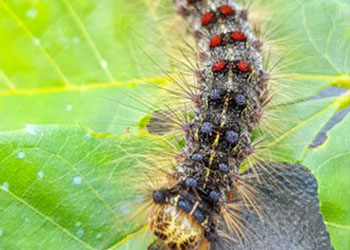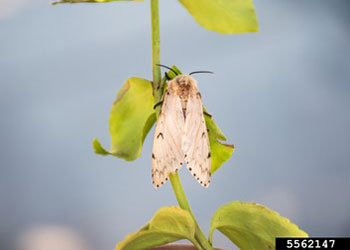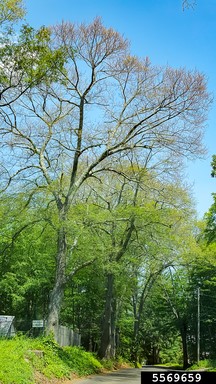PLANT PEST

Karla Salp, Washington State Department of Agriculture, Bugwood.org.
Spongy moth
Exotic to Australia
Features: Medium sized moths that infest and destroy many kinds of plants; large hairy caterpillars up to 7 cm long, with distinctive red and blue spots. They have formerly been referred to as ‘gypsy’ moths.
Where they're from: Asia, Europe, North Africa, North America
How they spread: Imported nursery stock, freight, cargo ships, containers
At risk: More than 1000 plant species including eucalypts and pine forests, fruit and nut trees
This pest is listed on both the National Priority Plant Pests and the National Priority List of Exotic Environmental Pests, Weeds and Diseases as it has the potential for significant plant industry/agriculture impacts and may also cause significant damage to our environment and social amenity.
Keep it out
Spongy moth species (Lymatria spp.) are destructive pests of forests and horticulture that are present in many areas of the world. They attack more than 1000 species of plants including fruit and nut trees, plantation forests, native species and ornamental trees. They breed quickly, laying egg masses that contain 100 – 1200 eggs. Large populations of caterpillars able to completely defoliate trees causing them to die.
The moths lay yellow egg masses on hard surfaces, usually tree trunks but also on logs, outdoor furniture, nursery stock, pallets, shipping containers and on the hulls and rigging of ships. This makes them good at hitchhiking around the world. Locally they can fly, but some also spread as larvae on silk threads.
If a spongy moth species established in Australia they would be extremely difficult and expensive to manage, and would cause problems for many farmers, foresters, threaten our natural environment and impact our gardens.
Importing goods
To keep spongy moths out of Australia, never ignore Australia’s strict biosecurity rules.
Import shipments may need to be treated and certified, so before you import, check our Biosecurity Import Conditions system (BICON).
What to look for
A spongy moth would be most likely to enter Australia in the egg stage. Look for dark yellow egg masses on:
- cargo ships
- commodities
- containers
- freight
- nursery stock
- plant parts
- vehicles.
The flight season (July – September) until hatching time (April – May) is the most likely time when eggs could enter Australia.
Also look out for the pest in the caterpillar stage, when it is large (up to 7 cm long) dark and hairy with two distinctive rows of blue and red raised spots along the back.
As moths, adult males are grey-brown with a wingspan of 3-4 cm and females are pale yellow with wavy dark brown bands and a larger wingspan of 4-7 cm.



Where to look
Importers
If you work around imported goods you need to look for spongy moths or their egg masses attached to:
- planes
- commodities
- freight
- nursery stock
- shipping containers
- vehicles
- vessels.
Growers and home gardeners
Look out for egg masses, caterpillars and moths on trees including:
- eucalypts
- fruit trees
- rose
- timber
- birch
- hemlock
- pines
- spruces
- oak
- ornamental plants.
Damage to crops
Spongy moths target:
- forestry
- nursery
- fruit
- nuts.
What to do
If you think you’ve found spongy moth:
- take a photo
- do not disturb the insect (this may be as simple as closing the doors on a shipping container or preventing access to an orchard)
- collect a sample, if it is safe to do so and if it doesn’t disturb the insects.
